The Best Adidas Running Shoes For Every Type Of Runner
Whether you’re lining up a marathon or a couch to 5K plan, Adidas has a shoe for you and this guide will help you find the right one
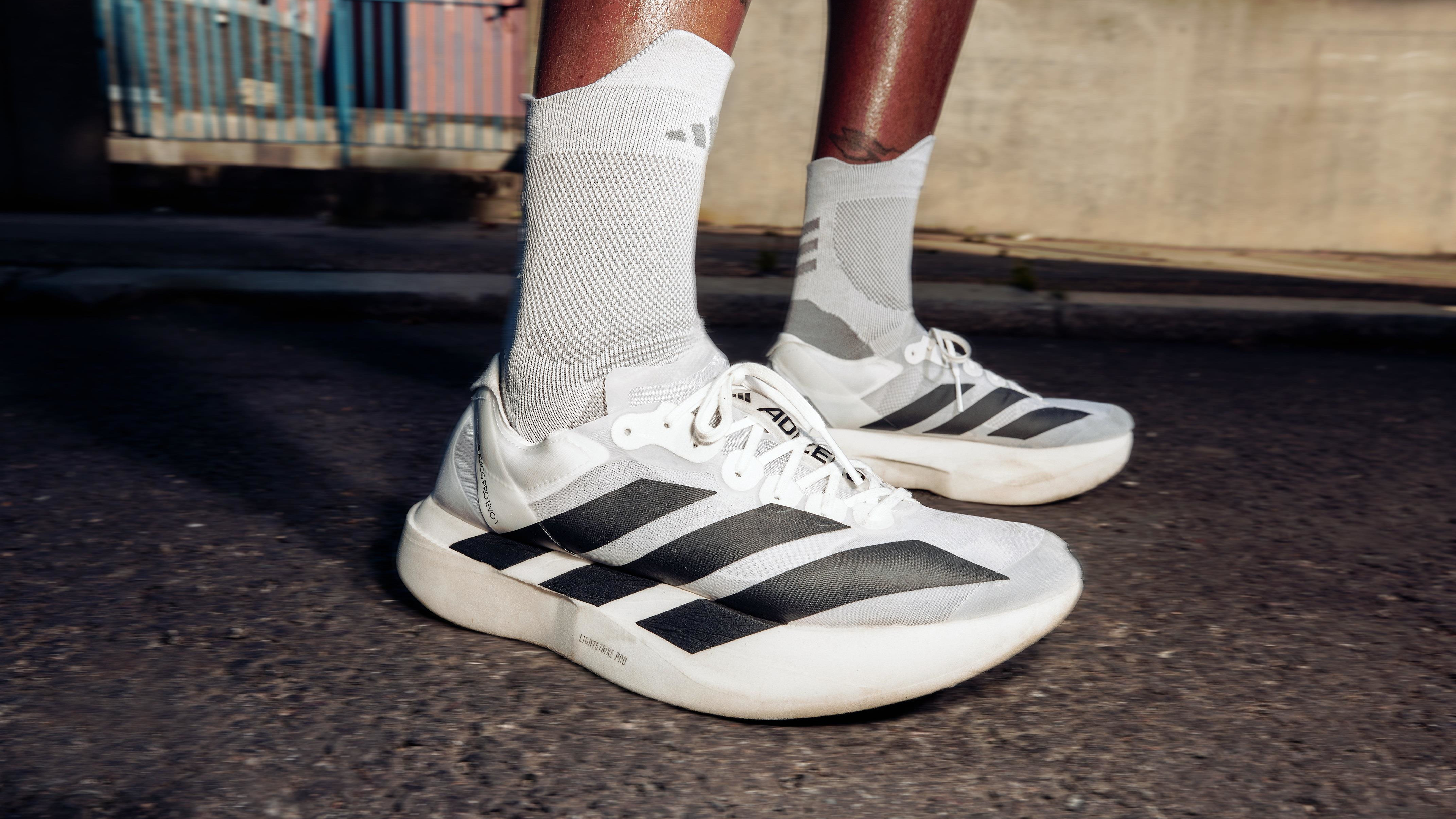
For newcomers to the sport it can be baffling to see how many different kinds of running shoes a brand like Adidas has in its line-up. Rest assured, though, there’s a reason for this breadth of range, and Coach can help you find your ideal shoe within it.
Adidas makes some of the best running shoes on the market, from speedy carbon racers to ultra-cushioned training shoes, and I’ve tested a whole load of them in recent years. The Adidas Adios Pro 3 is one of the best carbon plate running shoes, while the Adidas Ultraboost remains popular as a comfortable, cushioned shoe that’s stylish enough to wear outside running too.
When picking the best Adidas running shoe for you it’s wise to start by thinking about the kind of running you want to do. Are you a casual runner mostly doing runs of around 5-10km at whatever pace feels good on the day? Or are you training hard for a particular event like a marathon and undertaking a range of different training sessions like track, tempo, easy and long runs?
You should also consider whether you overpronate and therefore may need a stability shoe—getting gait analysis done at a running store can help identify this—and the surface you’ll be running on (road or trail).
How I Test Adidas Running Shoes
You can trust Coach
I usually run 50-60 miles a week on a mix of road, trails and track, following a structured training plan. I’ve been testing Adidas running shoes for many years and have extensive experience of popular lines like the Ultraboost, Adios and Boston.
The Best Adidas Running Shoes
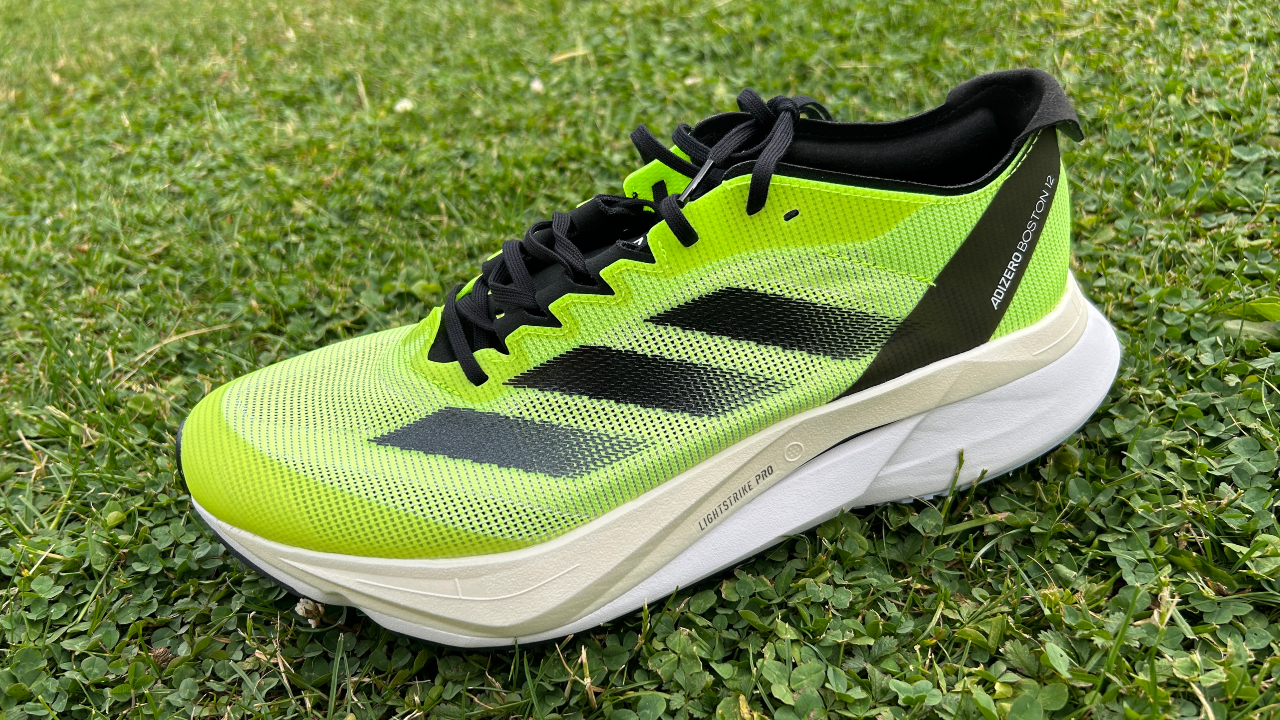
Specifications
Reasons to buy
Reasons to avoid
Adidas has made sweeping changes to the 12th edition of the Boston and vastly improved the shoe as a result. It’s one of the best all-round shoes on the market from any brand, with a comfortable and speedy ride that can handle pretty much any kind of run. It’s a great training partner shoe for a carbon racer like the Adios Pro 3 or a top pick for runners who like to have one running shoe in their locker to use for everything.
My only gripe with the Boston 12 relates to the upper, which lacks padding in some areas and can rub the heel. These are minor concerns, though, considering the excellence of the ride provided by the midsole, which is made from a combination of Lightstrike Pro and Lightstrike 2.0 EVA foams. The latter being softer and lighter than the Lightstrike EVA used in past Bostons.
Read more in my Adidas Adizero Boston 12 review
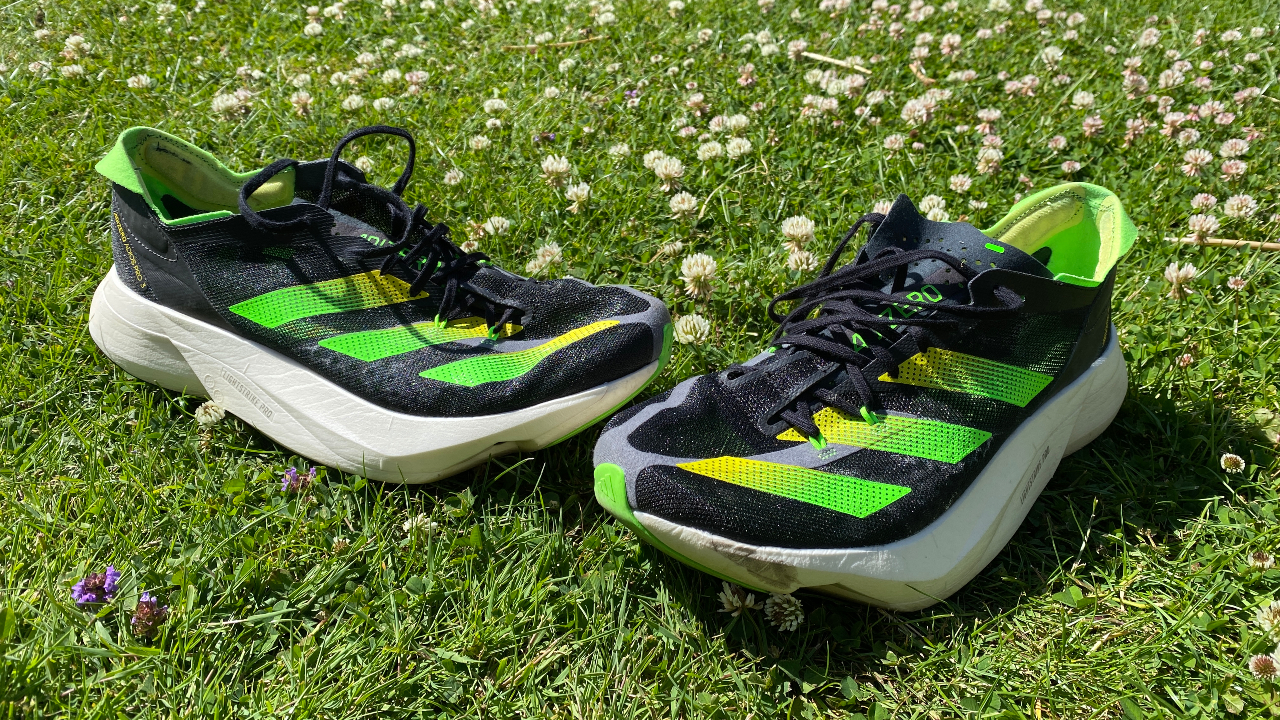
Specifications
Reasons to buy
Reasons to avoid
The Adios Pro 3 is the best race-legal carbon shoe in Adidas’s range (more on the best “illegal” shoe later) with a chunky midsole made of bouncy Lightstrike Pro foam. In the forefoot of that midsole are Adidas’s carbon EnergyRods, which connect to a small carbon plate under the heel to create the same propulsive feel of a full plate, with more flexibility under the forefoot.
I had to go half a size up in the Adios Pro 3 to get a comfortable fit around the forefoot, and even then the strange design has caused rubbing for many runners I know. If that doesn’t wreck your experience of the shoe, however, it’s a top-tier carbon racer, especially for longer distances.
Read more in my Adidas Adizero Adios Pro 3 review

Specifications
Reasons to buy
Reasons to avoid
I love the Boston 12 as a daily trainer, but the thin upper and lightweight, race-ready design will mean that some runners find it isn’t supportive enough for general use, especially when starting out with the sport, which is where the Supernova Rise comes in. It has a more padded upper than the Boston, and a more relaxed ride for day-to-day use, even if I found the Boston 12 more comfortable underfoot on long runs.
The Supernova Rise is a versatile shoe and it’s the best place to start with the Adidas range if you’re a new runner, offering a better ride and lighter design than the Ultraboost Light. It’s also good value, being cheaper than the Boston 12 and Ultraboost, and given Adidas’s welcome propensity for offering large discounts on its running shoes in big sales periods, you may be able to pick up the Supernova Rise for around $100 before long.
Read more in my Adidas Supernova Rise review

Specifications
Reasons to buy
Reasons to avoid
There are several versions of the Ultraboost in Adidas’s range, but the Ultraboost Light is the top one for runners. That’s all down to the lighter version of Boost foam used in its midsole, which cuts the weight considerably compared with the Ultraboost 22, making the Light more enjoyable to use for runs of any type.
It’s still pretty heavy and I found it worked well only for easy runs, when it offers a stable, fairly comfortable ride. It’s not as good as the best cushioned shoes from other brands, and it’s expensive for a training shoe, but the Ultraboost Light is a decent running shoe and a looker you can wear outside your training too.
Read more in my Adidas Ultraboost Light review

Specifications
Reasons to buy
Reasons to avoid
The Adios 8 is a major upgrade on the Adios 6 and 7. Adidas has improved the shoe by updating the Lightstrike EVA foam at the back to a version that’s softer and lighter, while also increasing the amount of bouncy Lightstrike Pro in the forefoot.
It’s a shoe that can hold its own with some of the best fast training shoes out there, while having a more traditional racing flat feel. It doesn’t protect the legs as much as higher-stack shoes or provide as much propulsion as a plated shoe, but the underfoot shank that runs from the midfoot to the forefoot does add pop for faster efforts.
The Adios 8 doesn’t match the performance of the Takumi Sen 9 or Adios Pro 3 in races, but it’s a good fast training partner for those shoes, and a lot cheaper. I prefer the Boston 12 as a more rounded shoe that’s still great for fast training, but if you crave the more grounded feel of a flat, the Adios 8 is one of the best available from any brand.
Read more in my Adidas Adizero Adios 8 review

Specifications
Reasons to buy
Reasons to avoid
The Adizero SL takes some of the ingredients of Adidas’s top shoes and brings them to a cheaper, fairly lightweight daily trainer. It has a chunk of Lightstrike Pro foam under the forefoot, but most of the midsole is made from Lightstrike EVA foam, which is a fairly firm material. The ride is softened a little by the rocker design, but the Adizero SL is still a firmer shoe and can be a little uncomfortable over long distances.
Stick to shorter runs in it and it is a versatile shoe, capable of handling both fast interval sessions and easy plods. The outsole grips pretty well too—I used it during a rare freezing period in London and it did a good job of keeping me upright on icy pavements.
Read more in my Adidas Adizero SL review

Specifications
Reasons to buy
Reasons to avoid
Adidas has thrown everything into the Prime X Strung 2, with its midsole containing not one, but two carbon-infused plates sandwiched between three layers of Lightstrike Pro foam. The result is a ludicrously bouncy ride that makes the shoe incredibly fun to use for a range of daily training runs, from long cruises to speedwork.
The fact that it’s a more stable shoe than the original Prime X Strung helps to make it a better all-round trainer, but the changes Adidas has made with the second version of the shoe have made it heavier. This means I’d prefer to lace up the Adios Pro 3 for races, or even the Adidas Adizero Adios Pro Evo 1, if you were one of the few hundred people able to snag that shoe.
Read more in my Adidas Adizero Prime X 2 Strung review
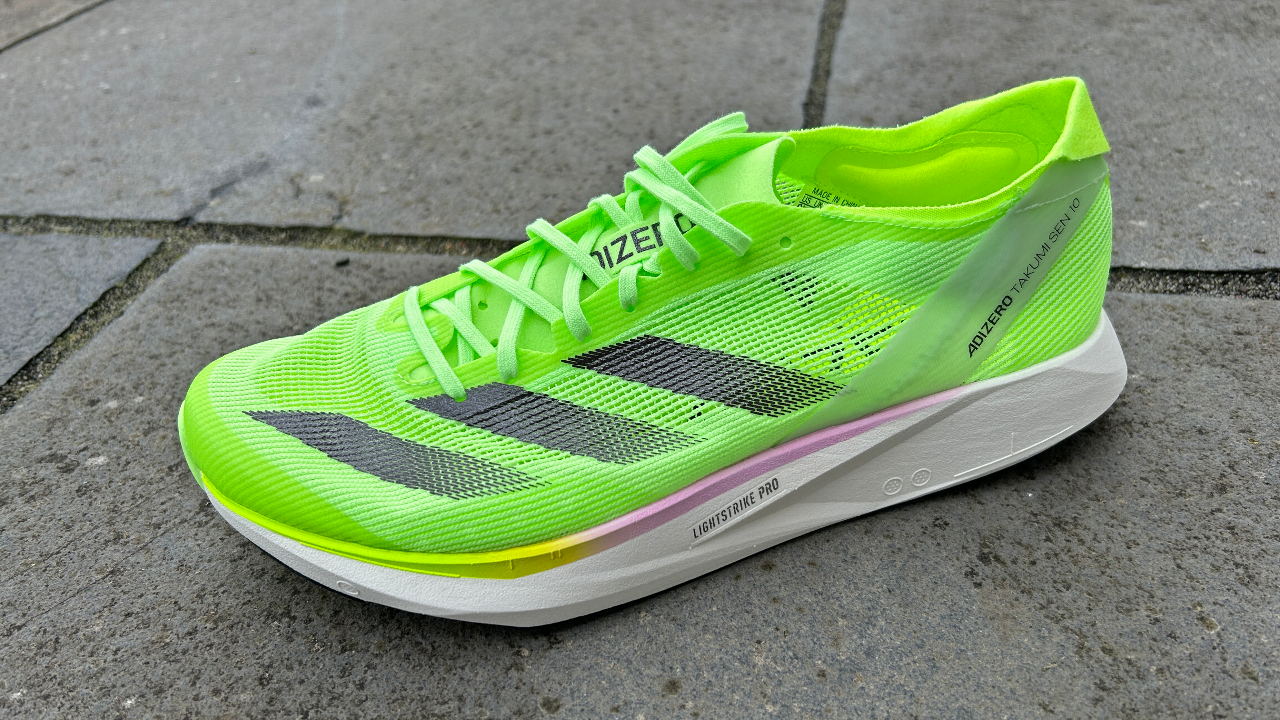
Specifications
Reasons to buy
Reasons to avoid
The Adios Pro 3 is the best overall racer from Adidas, with its more propulsive ride making it better for long races and events on flat, mostly straight courses than the Takumi Sen 10. However, the Takumi is more agile when you’re tackling twists and turns. I prefer it for short events in general because it’s lighter than the Adios Pro 3, and I set my five-mile PR of 26min 6sec during my testing of the shoe.
I also love the Takumi Sen 10 for training runs, where its nimble design is great for speed sessions on roads where you have to dodge around obstructions and other people, and it’s fantastic for track reps as well. It has the feel of a racing flat with some of the spring of a super-shoe, and is simply a lot of fun to run fast in.
It’s expensive to buy alongside the Adios Pro 3, which is still a great option for short events itself, but the Takumi Sen line is often reduced in sales periods. If you can get the Takumi Sen 10 in a deal, it’s worth having in your rotation as a lightweight speedster that excels in certain conditions.
Read more in my Adidas Adizero Takumi Sen 10 review
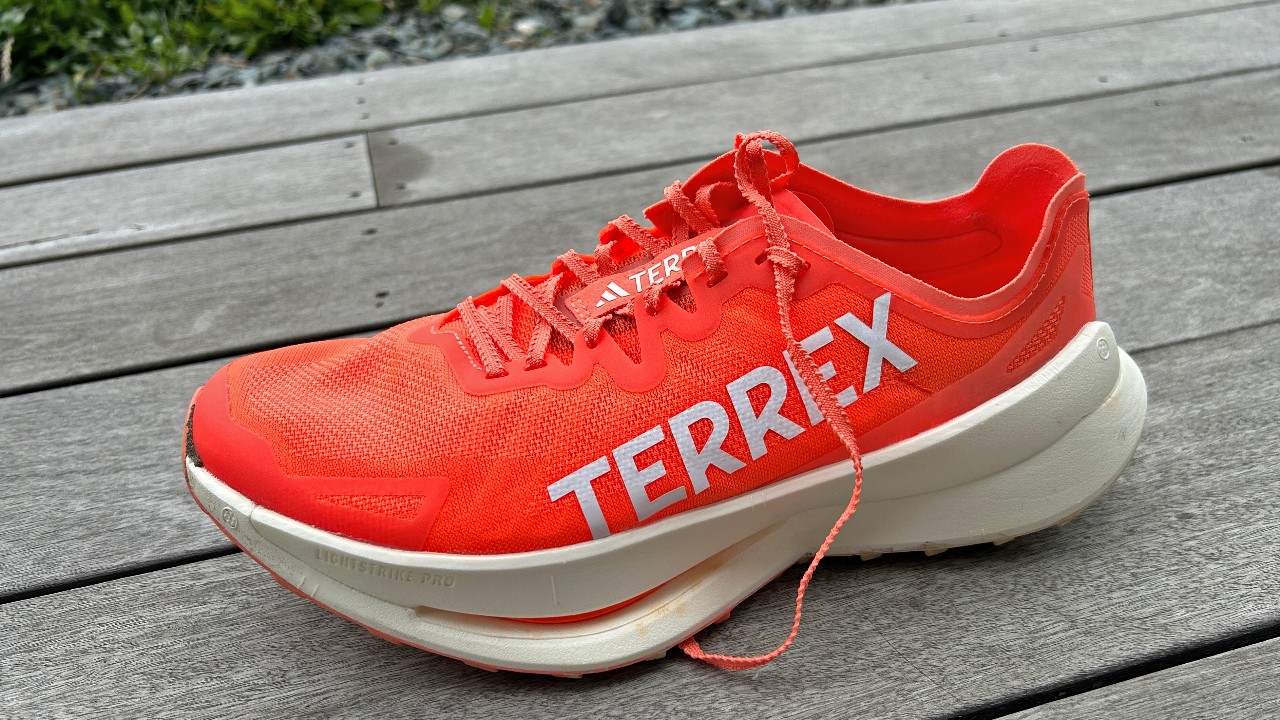
Specifications
Reasons to buy
Reasons to avoid
The Adidas Terrex Agravic Speed Ultra is a trail-running shoe that’s built for speed, with a Lightstrike Pro midsole that contains a plastic version of the propulsive EnergyRods used in Adidas’s fastest road shoes. The Agravic Speed Ultra also has an aggressive rocker to push you onto your toes and help you maintain a fast pace over any distance and terrain.
I loved using the shoe for runs at a range of speeds and over a range of distances, with my longest run being a 30-mile run on forest trails. It’s not the most stable shoe, and I think only experienced trail runners will be comfortable using it on steep mountain descents, however the Adidas Terrex Agravic Speed Ultra is the best trail super-shoe I’ve tested from any brand. If it’s a bit too outlandish, and expensive, for you, then the Adidas Terrex Speed Ultra is a good alternative.
Read more in my Adidas Terrex Agravic Speed Ultra review

Adidas Terrex Speed SG
Specifications
Reasons to buy
Reasons to avoid
If your trail runs are mostly on muddy ground or fells then the Terrex Speed SG is the best off-road option in Adidas’s range. It has 7mm chevron-shaped lugs that I’ve found grip well on steep, grassy descents as well as in deep mud. Despite the large lugs the shoe is impressively light and I found it a great cross-country racing option, especially as the upper drains rapidly and the outsole sheds mud well.
On harder ground it’s not the most comfortable shoe thanks to the relatively low stack of midsole foam, but if you’re on softer terrain it’s a solid long-distance option. I took it out for a three-hour, 27km run in the Scottish Pentlands with plenty of fast downhills and it protected my legs well.
What about the Adidas Adizero Pro Evo 1?
One shoe that is conspicuous in its absence from the list above is the Adidas Adizero Pro Evo 1, the brand’s best carbon plate running shoe and the one used by its elites. The Pro Evo 1 is incredibly lightweight, weighing just 138g (4.86oz), but still has a 39mm stack of a special version Lightstrike Pro foam at the heel, and has been used to win many races and set world records since it came out in September 2023.
I have not been able to test the Adidas Pro Evo 1 yet, which is the main reason why it doesn’t feature, but I also think that the Adidas Adizero Adios Pro 3 is probably going to remain the best overall Adidas racing shoe for most people anyway.
That’s because the Pro Evo 1 is incredibly expensive at $500/£450, as well as being very hard to get hold of—it’s only been on sale in very limited quantities on a couple of occasions so far, with the ‘lucky’ winners of a ballot being allowed to buy the shoe.
Furthermore, the shoe is not designed to be very durable. It’s a shoe that elites will probably use for one race and then have a fresh pair on for their next race. It’s not going to fall apart after one race, but for amateur runners looking for a shoe that will remain at or near its best for multiple races, the Adios Pro 3 is going to be the more durable option.
Adidas is likely to introduce some new carbon plate running shoes in 2024 and I’m hoping that some of the incredible features of the Pro Evo 1 do trickle down to more attainable and durable shoes for amateur runners, including the new version of the Adios Pro. For now, if you can get hold of the Pro Evo 1 and don’t mind the outlay, it could well be the best race day shoe you can buy from any brand, but unless you’re an elite the smart money is probably spent on the Adios Pro 3.
Sign up for workout ideas, training advice, reviews of the latest gear and more.

Nick Harris-Fry is a journalist who has been covering health and fitness since 2015. Nick is an avid runner, covering 70-110km a week, which gives him ample opportunity to test a wide range of running shoes and running gear. He is also the chief tester for fitness trackers and running watches, treadmills and exercise bikes, and workout headphones.
